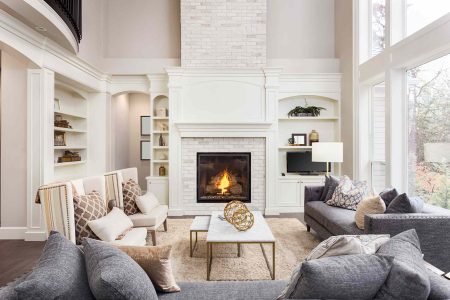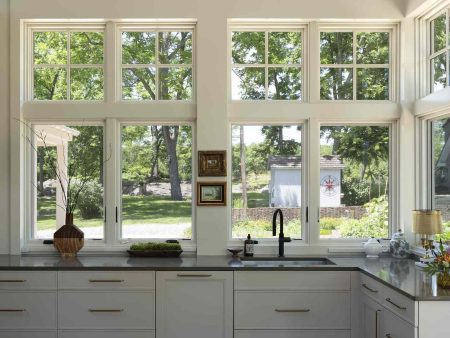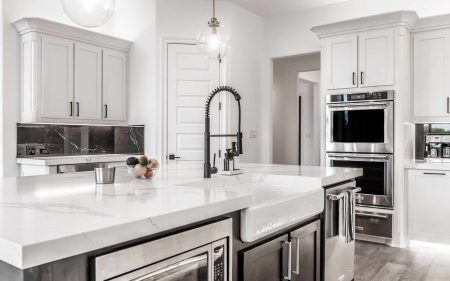Whether it’s a large-scale project or a do-it-yourself rehab, you’ll adore your newly remodeled living room. But you’ll love it even more when it comes time to sell and your living room projects realize a high return on investment (ROI). These living room remodel ideas are sure to pay off upon resale.
-
01
of 05Expand Your Living Room
In years past, living rooms traditionally were kept tight and compact to conserve energy. But with the open floor plan movement of the mid 20th century, coupled with today’s need for more space, home buyers expect living rooms that are larger than ever.
If you have a room adjoining the living room that you don’t mind sacrificing, you can remove an interior non-load-bearing wall and take over that space. While a messy job, it’s not all that complicated and it can be done by a motivated homeowner. Just make absolutely sure that the wall is not load-bearing and that you have secured all permits.
One alternative to an open plan is a broken plan home, which provides small niches of privacy while still maintaining an overall sense of openness. You can define these sub-spaces with half-walls, glass walls, pillars and columns, or with non-permanent pieces such as bookcases.
-
02
of 05Replace or Refresh Your Front Entry Door
Do you want a home remodel project that does double duty? If your living room is at the front of your house, installing a new entry door or freshening up your current door can do so much for so little cost and effort.
A front door refresh accomplishes two things for the price of one. Not only does it charge up your home’s exterior curb appeal, but it also adds a new sparkle to your front living room.
According to Remodeling magazine’s Cost vs. Value Report, a new entry door has a higher ROI than nearly every other home project, bringing back over 91 percent of its cost upon sale. That sky-high ROI is due, partly, to the extremely low cost of this project.
-
03
of 05Let in the Light With New Windows
Living rooms are for living, and nothing stimulates that feeling like natural light streaming through your windows.
If you’re like other homeowners, your living room windows just might be tired, drafty, and sorely lacking in light transmittal. Give your window spaces a second life by replacing them with new windows. New windows recoup a healthy 70 to 75 percent of their original cost.
In addition, you’ll save energy and money by replacing poor windows with weathertight windows.
With this mid-century modern influenced living room, Washington, DC’s Balodemas Architects created generously sized windows to let a maximum amount of natural light pour in.
-
04
of 05Choose the Perfect Color Palette
In no other room of the house is color so important as in the living room. Whether it’s used for hanging out, watching movies, reading, or sipping wine, the living room always gets plenty of face time. With so much attention focused on this area, the color scheme must be spot-on perfect.
Interior painting is usually one of those no-brainer ROI projects. Because the cost of tools and materials is so incredibly low, you’re sure to realize great returns in buyer appeal.
But you’ll need to choose a living room color palette that appeals to a majority of buyers. White, gray, beige, and other neutrals lead the pack in terms of colors that tend to be mutually liked. Brown, gold, and earthy orange push the living room’s color register to bolder reaches, capturing the attention of would-be buyers. Deep blue living rooms communicate a sense of rich tradition, while lighter blues evoke the breezy, carefree feeling of a day at the seaside.
Continue to 5 of 5 below. -
05
of 05Create Faux Extra Space
Whether or not you have bumped out a wall to make more living room space, you’ll still want to create the illusion of greater space on the cheap with simple techniques. Making faux extra space saves on remodel costs while potentially making your living room more tempting to buyers.
- Ceiling: Make sure that the ceiling is white, in order to avoid a claustrophobic feeling.
- Area Rug: Don’t make the mistake of having an area rug that is too small. Aim for between 10 to 20 inches of bare floor space between the edges of the rug and the walls.
- Shelves: Mount shelves high, near the ceiling, to pull the eye upward.
- Storage: Build or purchase storage units that hug close to the wall. Getting clutter out of sight vastly improves the look of any room and instantly makes it feel larger.
- Statement Piece: A large, colorful, or otherwise showy statement piece like a chandelier captures the eye and makes the room feel larger.
The living room featured here from Kari Arendsen at Intimate Living Interiors previously had dark ceilings and furniture, making it appear much smaller than it really was. A total upgrade, the lighter colors, statement lighting, and big, bright rug totally open up the space.
Read the full article here
